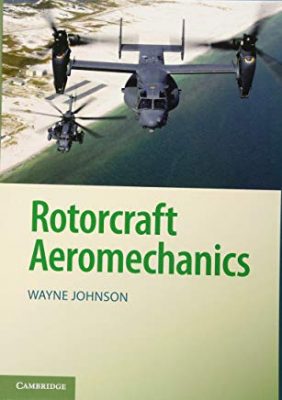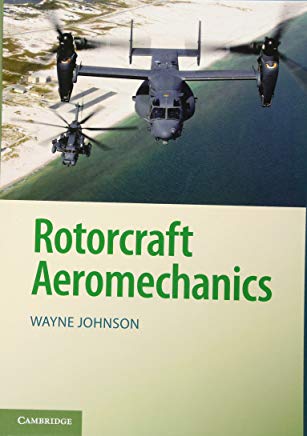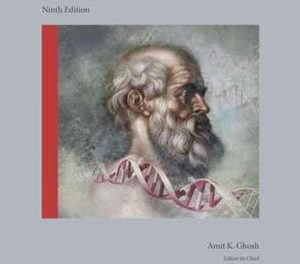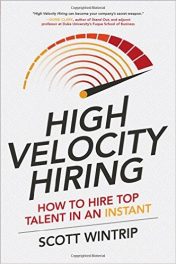 Author: Wayne Johnson
Author: Wayne Johnson
Publisher: Cambridge University Press – 927 pages
Book Review by: Sonu Chandiram
Rotorcraft refers to aircraft wherein rotors are part of their equipment. Sometimes they are called VTOL (vertical takeoff and landing) aircraft, A common example of such aircraft is the helicopter. There are many types of helicopters, such as single main motor and tail rotor, tandem rotor, and coaxial rotor. Other rotorcraft besides the helicopter are: tilting proprotor aircraft, compound helicopter, and other types.
In most studies of aeromechanics, these are some of the topics studied: flight dynamics, loads, noise, performance, stability, and vibration.
This book of over 90 pages presents discussions, formulas, and illustrations on what engineers need to know about rotorcraft aeromechanics, particularly problems encountered in design, as well as performance. Its focus is on analysis. Calculated results are shown to illustrate analysis characteristics and rotor behavior.
This book contains 22 chapters that we list below to provide you an overview:
- Introduction
- Notation
- Hover
- Vertical Flight
- Forward Flight Wake
- Forward Flight
- Performance
- Design
- Wings and Wakes
- Unsteady Aerodynamics
- Actuator Disk
- Stall
- Computational Dynamics
- Noise
- Mathematics of rotating Systems
- Blade Motion
- Beam Theory
- Dynamics
- Flap Motion
- Stability
- Flight Dynamics
- Comprehensive Analysis
The author writes that many dictionaries these days do not have a broad enough definition of aeromechanics and those definitions do not reflect the multidisciplinary facet of this word as it applies to aircraft. His definition of aeromechanics is this: “Aeromechanics is the branch of aeronautical engineering and science dealing with equilibrium, motion, and control of classic rotorcraft in air.”
Wayne Johnson authored a book in 1976 on rotorcraft aeromechanics entitled Helicopter Theory that was published in 1980 by Princeton University Press (and republished in 1994 by Dover Publishing. It had many concepts covered in it that are also touched upon in this one.
He writes that the present book is written with the assumption that many readers have a general knowledge of aeromechanics fields such as beam theory, classical dynamics, lifting-line theory, and two-dimensional airfoils. But he does provide introductory details where needed.
This book is based on the author’s experience, and it does not include coverage and discussion on topics such as materials, propulsion, and structures. All in all, this is a good book for those who want to design and build aeromechanics aircraft.
Author:
Wayne Johnson worked at the U.S. Army Aeromechanics Laboratory from 1970 to 1981 at the NASA Ames Research Center. He was with NASA from 1981 to 1986, including several years as Assistant Branch Chief. Dr. Johnson founded Johnson Aeronautics in 1986, where he developed rotorcraft software.
Since 1998, he has worked at the Aeromechanics Branch of NASA Ames research Center. Dr Johnson is the author of the comprehensive CAMRADHI and the aircraft design code NDARC and of the book Helicopter Theory (1980). He is a Fellow of the American Institute of Aeronautics and Astronautics (AAA) and the American Helicopter Society (AHS).
He received a U.S. Army Commander’s Award for Civilian Service, NASA Medals for Exceptional Engineering Achievement and Exceptional Technology Achievement, the AHS Grover E. Bell Award, the Ames H. Julian Allen Award, the AIAA Pendray Aerospace Literature Award, and the 2010 AHS Alexander Nikolsky Honorary Lectureship.







